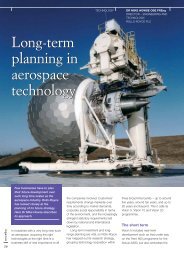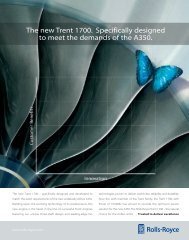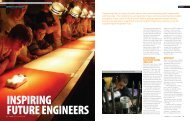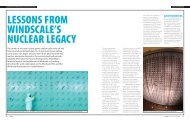Gas turbine technology - Ingenia
Gas turbine technology - Ingenia
Gas turbine technology - Ingenia
Create successful ePaper yourself
Turn your PDF publications into a flip-book with our unique Google optimized e-Paper software.
EARTH, AIR AND WATER<br />
ingenia<br />
16<br />
blade exerts a centrifugal force of around<br />
70 tonnes, equivalent to the weight of a<br />
modern locomotive, the resulting fan set<br />
is far lighter than those in competing<br />
powerplants, contributing significantly to<br />
the Trent’s overall weight advantage.<br />
Figure 4: The wide-chord fan blade.<br />
This innovation was first introduced on<br />
the Trent 700 for the Airbus Industrie<br />
A330 in 1995. It has since been<br />
optimised for all derivative Rolls-Royce<br />
Trent engines either in service (with the<br />
Trent 800 on Boeing’s current 777) or in<br />
development. The Trent 500 for Airbus<br />
Industrie’s A340-500/600, scheduled to<br />
enter service next year, features the<br />
WCFB; an advanced ‘swept’ version is<br />
being designed for the Trent 900 under<br />
development for the European<br />
manufacturer’s super-large A380 aircraft<br />
programme.<br />
Trent <strong>technology</strong>: the highpressure<br />
<strong>turbine</strong> blade<br />
<strong>Gas</strong> <strong>turbine</strong> aero engines are<br />
assembled from components made to<br />
specifications matched by few other<br />
industries in their exacting<br />
requirements. Advanced materials<br />
research plays a key role in the design<br />
process, in particular for highperformance<br />
parts which require<br />
resilience to extreme environments. An<br />
end product of this discipline is the<br />
High-Pressure Turbine (HPT) blade. The<br />
function of HPT blades (92 of which are<br />
employed in a Trent 800 engine) is to<br />
extract power from the hot gas stream<br />
exiting the engine’s combustion<br />
chamber, in order to drive the six stage<br />
High-Pressure Compressor (HPC).<br />
First, the blades must be immensely<br />
strong and robust. Each HPT blade<br />
operates at a speed of 10,000 rpm and<br />
extracts around 750 horse power –<br />
about the same as a Formula 1 racing<br />
car. The blades will average a minimum<br />
of 15,000 hours in service between<br />
engine overhauls. An aircraft will have<br />
flown approximately eight million miles<br />
during this period. As HPT blades do<br />
their work in the hottest part of the<br />
engine core, they must also be able to<br />
function at peak performance in gas<br />
temperatures of up to 1600°C.<br />
Comprising an advanced nickel alloy<br />
base with additions of cobalt, chromium,<br />
tantalum, tungsten, aluminium, rhenium<br />
and other trace elements, additional<br />
strength is derived by the specially<br />
controlled casting process which<br />
removes the normal formation of<br />
solidifying grains in the metal. These<br />
grains, with boundaries between them,<br />
are potential sites for impurities and<br />
weakness. Control of the solidification<br />
process allows the blade to be cast as<br />
one single crystal of nickel alloy with no<br />
grain boundaries. The resulting blade has<br />
a temperature melting point of between<br />
Figure 5: Cutaway of an HPT blade.<br />
1200°C and 1300°C and operates at an<br />
average metal temperature of 1000°C.<br />
Its hollow design allows air to flow<br />
through internal passages to cool the<br />
component, before passing through<br />
holes to form a protective film over the<br />
blade surface. ‘Cool’ air temperatures<br />
are, in the case of a large civil turbo fan<br />
engine, in the region of 650°C.<br />
Reducing environmental<br />
impact<br />
The continual reduction of emissions<br />
and noise continues to be at the<br />
forefront of advanced aero engine<br />
design. But designing an engine which<br />
achieves both optimum performance<br />
and low emissions presents a<br />
conundrum at the epicentre of<br />
advanced aero engineering.<br />
Increased temperatures improve the<br />
thermodynamic cycle and the engine<br />
fuel efficiency; indeed, since the 1960s<br />
the fuel burnt per passenger seat has<br />
more than halved due to improved<br />
engine <strong>technology</strong> and lighter aircraft<br />
designs. This has a direct benefit in<br />
reducing the amount of CO 2<br />
produced.<br />
However, nitrogen and oxygen – both<br />
present in the atmosphere – react at<br />
very high temperatures and this<br />
chemical reaction produces nitrogen<br />
oxides, NOx, a contributor to acid rain.<br />
The higher the air temperature and<br />
exposure time to these high<br />
temperatures, the greater the<br />
production of NOx.<br />
Advanced combustion <strong>technology</strong><br />
has come a long way in addressing<br />
these issues. Today by-products such<br />
as soot, smoke, hydrocarbons and<br />
carbon monoxides have all but<br />
disappeared. Emissions of nitrogen<br />
oxides have been reduced by making<br />
improvements to combustor mixing<br />
processes by lowering peak gas<br />
temperatures and reducing burning<br />
exposure time in the ‘hot spots’ of the<br />
combustion chamber.<br />
Great strides have been made by<br />
the aviation industry during the last 30<br />
years in reducing noise pollution. About<br />
20 decibels (a fourfold reduction) has





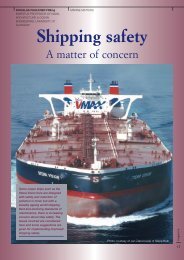


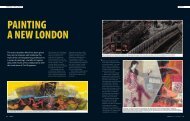
![[322/03] Francke - Ingenia](https://img.yumpu.com/23411337/1/184x260/322-03-francke-ingenia.jpg?quality=85)

